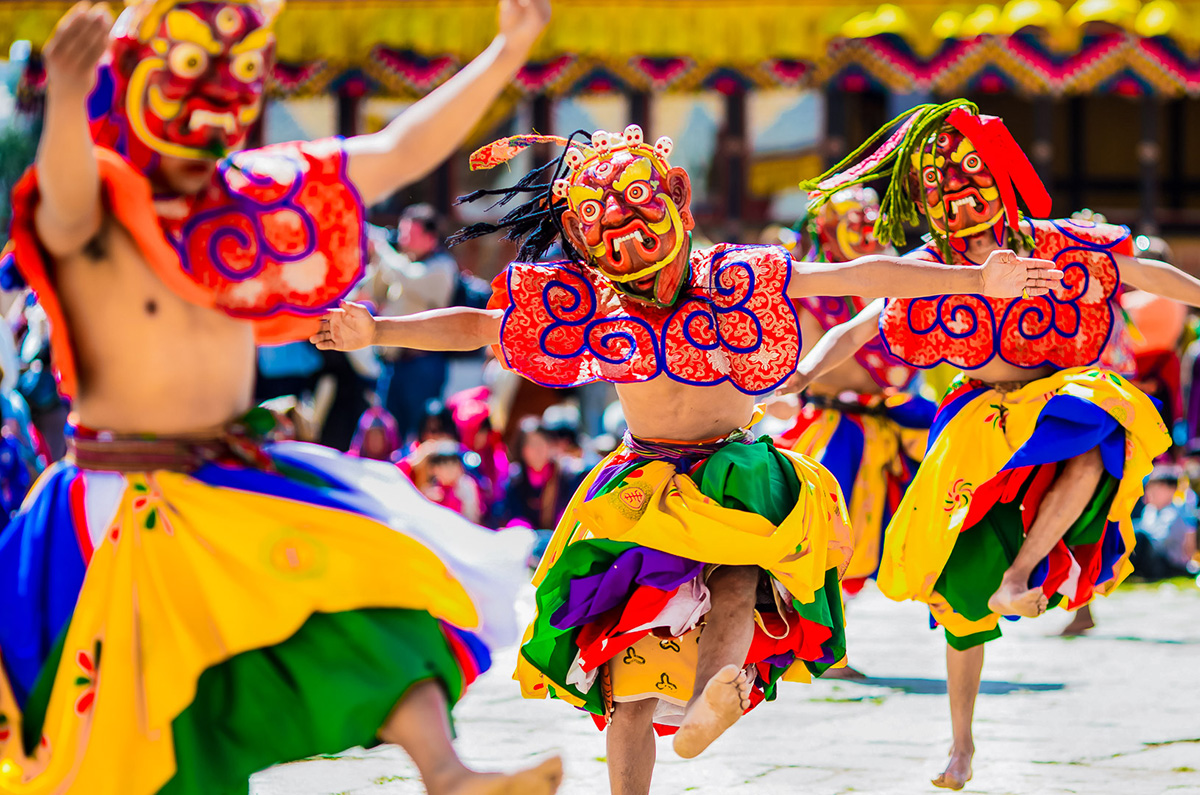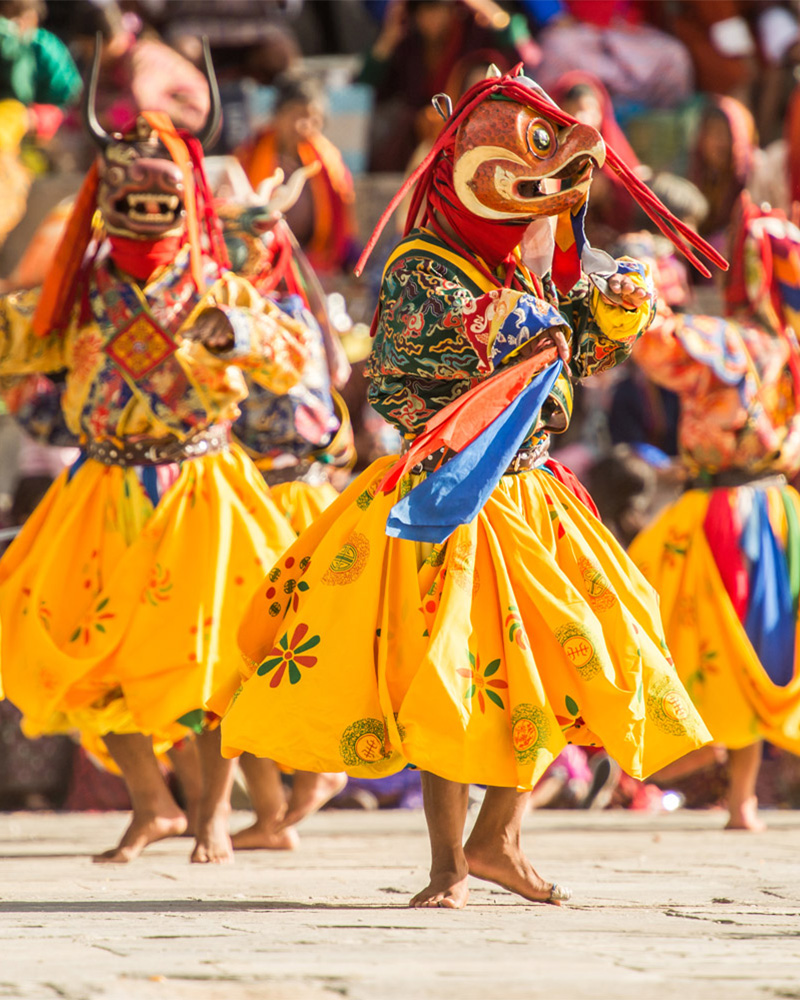Bhutan has seasonal tariff that is categorised into the high season and low season. A major factor in choosing the best time to visit Bhutan, aside from the weather patterns is the festival schedule.
Spring is the favourite season for tourists to visit Bhutan as the weather is ideal and it’s an excellent time for trekking. The valleys are green and lush as spring brings new growth with rhododendron, wild azaleas and wildflowers blooming in March to May.
Spring recommendations

*Advanced booking is highly recommended as flight tickets and hotels will be fully booked as early as January for the Spring season.
Paro Tshechu is the most popular dance festival in Bhutan. This significant religious festival has been held annually since the seventeenth century when Zhabdrung Ngawang Namgyel and Ponpo Rigzin Nyingpo initiated the festival together with the consecration of Paro Dzong (fortress) in 1644. Paro Tshechu is held for five days and it will provide visitors with a great understanding of Bhutan’s rich culture and history.

Although monsoon seasons start from June to August, Bhutan usually experiences only light showers in the afternoon. Occasionally there will be drizzles that last through the entire day. This is the best season if you would like to have a closer and clear view of the Himalyan mountains and indulge in the lush green paddy fields. With lesser crowds during the summer, you will also get to better soak in the atmosphere in the different attractions. With the days being longer in summer, you will also get to explore more places as compared to the other seasons.
Summer recommendations
Set among pristine lake and high alpine valleys, the Haa Summer Festival is a vibrant celebration of traditional Bhutanese cultures, nomadic lifestyles, unique Bhutanese cuisine, traditional sports and religious performances. Visitors will get a chance to immerse into the lives and traditions of Bhutan’s nomadic herders. You can also expect to see a variety of yak products on display and learn about traditional Haa cuisine made from yak dairy. Visitors can also experience the night at one of the many village homestays and enjoy the warm hospitality of the local people of Haa Valley.
At Masutake Festival, native mushroom and other local products will be sold, mushroom hunting, and cultural programmes by the school and local community will be showcased. The objectives of the festival is to create awareness on the sustainable harvesting of the local mushroom and enjoy the organic natural flavors of nature.
Autumn is also a peak season for Bhutan due to the pleasant mild weather with clear and crisp blue skies. It is also one of the best times for trekking as the climate is cool and temperate. You will also get to bask in the beautiful landscapes with rice fields turning gold before harvest.
Autumn recommendations
Jambay Lhakhang Drup is a unique religious festival held annually in the beautiful Bumthang valley. It is also one of the most important festivals in Bhutan to commemorate the building of Jambay Lhakhang temple and to honour Guru Rinpoche who consecrated the temple. The festival showcases many traditional Cham dances, Ter cham (the Naked Dance), and Mewang cham (the fire blessing) are amongst the most popular ones. During the fire blessing ceremony, locals run through a giant flame to purify their sins while the sacred naked dance is performed at the stroke of midnight by sixteen naked men. Bhutanese believe that the sacred dance will provide blessing to infertile women to have children.
The black necked crane festival is held annually at the courtyard of Gangtey Monastery. Every November, locals will flood the monastery’s courtyard to witness and celebrate the arrival of the rare majestic black-necked cranes during the winter season. The festival is organised to generate awareness and understanding on the importance of conserving the endangered black-necked cranes. The festival showcases cultural programs such as folk songs and dances, mask dances performance, crane dances and environmental conservation-themed dramas and songs by school children. The black-necked crane is a sacred bird in Bhutan that symbolises longevity.

Winter is the best time if you want to have an exclusive experience in a snowy landscape in Bhutan. The weather can be cold in December but the lowest temperature usually takes place near the end of January. Snowfall can be expected in the higher regions and heavy snowfall may cause some of the roads to central or eastern Bhutan to be unpassable. If you would like to experience a less crowded Bhutan, winter is the time to visit as there will be less tourists during this season. If you are lucky, you might even be able to see snow during your hike up the Takstang (Tiger’s Nest Monastery)
Winter recommendations
Druk Wangyel Tshechu established in 2011, is a special festival held as a tribute to the wise leadership of the Fourth King, His Majesty Jigme Singye Wangchuck and the Armed Forces’ victory over the Indian insurgent forces in 2003. The festival is uniquely performed by Royal Bhutan Army instead of the monks or lay people. The festival is held annually on 13 December near Druk Wangyel Lhakhang located at Dochula Pass. Dochula Pass is deemed as one of the most scenic mountain passes in Bhutan which offers a stunning view of the Himalayan mountain range.
Aside from Paro Tshechu, Punakha Tshechu is another acclaimed festival held right after the popular Punakha Dromche. Punakha Dromche is a dramatic reenactment of the battle scenes with the Tibetan army during the Zhabdrung era in the 17th century. The pazaps (militia men) will dress in traditional battle gear to reenact the ancient battle scenes. This five-day long festival is held inside the ancient capital and most beautiful fortress of Bhutan, Punakha Dzong. The unfurling of the thongdrol (a large painted scroll) measuring 83ft by 93 ft, the largest one ever made is the main attraction of the festival. It took 51 artists and two years to complete the thongdrol depicting 20 of the greatest gurus and sages around the central figure of Shabdrung.